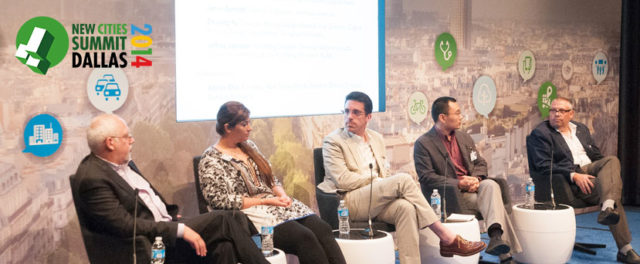Cultural Districts: Engines of Urban Transformation
November 28, 2014 — Blog
This post is part of our Re-imagining Cities discussion series, following the third edition of the NewCities Summit in Dallas in June 2014.
The focus of this panel was on analyzing how to bring together the arts community to create cultural districts that are vibrant and engaging for citizens.
Manal Ataya showcased the investments the emirate of Sharjah is making in creating a sustainable cultural district. Jamie Bennett argued that cities must understand that every community has art and artists, and that the arts must be placed at the seat of every urban planning session. “Create a pattern of foot traffic and cluster arts organizations, buildings and communities together”, he said.

Zhiyong Fu highlighted China’s huge budget for developing cultural districts, particularly in Beijing, and how they are looking at ways to involve people and students into cultural policy. Jeffrey Johnson offered more insights into the huge museum boom going on in China. In the 1990s, the US witnessed a museum boom where about 30 museums were being built per year. Johnson contrasted this figure with what is going on now in China, where about 400 museums are being built annually. Whilst China does not have a history of philanthropic support of culture, Johnson pointed out that many private collectors are building their own museums in China today.
Make sure to engage your local population and know what they think – Manal Ataya
The panelists then offered their advice on best practices to consider. Ataya stated that master planning is not done enough: “Make sure to engage your local population and know what they think”. Bennett encouraged cities to stop planning cultural districts and instead think about the cultural district as creative place making, where citizens can approach and enjoy the place in a variety of ways, and where arts and culture are a means rather than an end. Zhiyong Fu stated that it is important to address the content of space, and to create a real network by using technology. Johnson gave the example of China where there is a culture district of 1 million square feet currently under construction. The scale is so enormous, Johnson said, that you have to look at the project as a living organism.
Bennett ended the discussion with the example of St. Paul, Minnesota’s green light rail construction. 500 artists were partnered with businesses using micro grants and, over a two-year period, produced over 200 events, revitalizing a disadvantaged neighborhood. Engaging artists, argued Bennett, changed the identity of the neighborhood and made it a cultural district.
Speakers
- Manal Ataya, Director General, Sharjah Museums Department, Government of Sharjah
- Jamie Bennett, Executive Director, ArtPlace America – @sarmoti
- Zhiyong Fu, Vice Director, Information Art and Design Department, Academy of Arts and Design, Tsinghua University – @ZhiyongFu
- Jeffrey Johnson, Founding Director – China Megacities Lab, Columbia University, Co-founding Principal, SLAB
Moderated by: Adrian Ellis, Founder, AEA Consulting , Director, Global Cultural Districts Network – @aea_consulting,
@GCDNet
